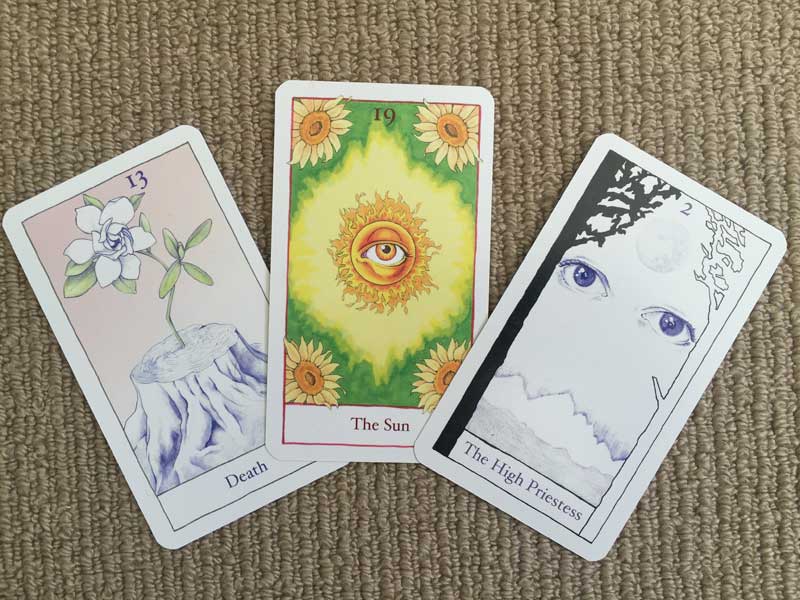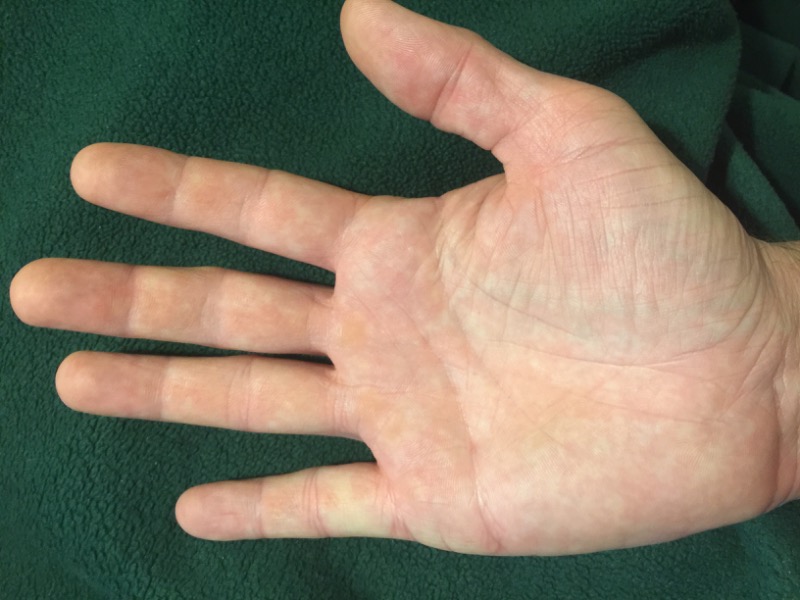Example Tarot Reading
read by
Artificial Intelligence
| Deck: 1909 Waite Smith Tarot | Created on Phuture Me |

Kingdom: A country ruled by a king (or queen).
Empire: A group of countries (under one ruler).
The Empress is the Queen of Queens. Each Queen in the Minor Arcana reigns over one elemental domain. The Queen of Cups is the feminine ruler of Water. The Queen of Pentacles is the feminine ruler of Earth. The Empress is ruler of all 4 Elemental Kingdoms.
In the Rider Waite Smith (RWS) Tarot deck the direction in which the Empress and Queens look is a significant detail. The Queen of Swords faces right, or East, and gestures with her left hand in that direction. She is focused entirely on the future. Her back to the past, no interest in the present. The Queen of Wands is almost with us in the present. Her body is facing front though her attention is drawn to the future with her head turned to the right. The other two Queens are both lost in the past, facing left, or West.
The direction in which a character is facing is an important, subtle and often missed, detail in cartomancy's symbology. It tells us about the querent's state of mind and where their attention and focus is. If someone is unhappy they tend to be lost in the past or worrying about the future. They are never fully in the present moment. If you look closely at each of the RWS's Queens you'll see that they each lack something. The Queen of Wands has no water, The Queen of Swords no vegetation.
The Empress has it all. She is beautifully dressed, wearing a crown, holding a sceptre, has a water running through rich fertile lands, trees in the background and a clear bright yellow sky. There is something missing though. In Tarot you must also be aware of what’s not in the picture, what’s missing, as well as what is there. The tall trees behind her protect her, and her lands, from strong winds. This is the element of Air kept in check and controlled.
Her attention is fully with us. She sits relaxed looking directly at you. She is content and happy with what she has right now. The Empress often represents where a woman wants to be in life.
The Empress embodies femininity, fertility, beauty, creativity, self expression and feminine desires. Her empire is a harmonious blend of all the elements which nurture creativity and growth. Although the RWS deck's Empress shows no child or pregnancy, other decks often depict her either pregnant or nursing a baby or both symbolising fertility. This card can point to a pregnancy or the desire to be fertile and pregnant. The symbology often contains references to Venus, the Greek and Roman goddess of love, beauty and fertility. Venus in Latin translates as love or sexual desire. The appearance of The Empress can indicate plans, events or endeavours that have not yet come to fruition but are gestating, growing and receiving, or needing, nurture. As a person she can be a mother, or mother figure.
Numerology: The Empress is card number 3 of the Major Arcana. This is the number of creativity, joy, good fortune, self expression and social gatherings.
© Phuture Me Ltd 2010-2018. All rights reserved.
THE PICTORIAL KEY TO THE TAROT
By Arthur Edward Waite (1911)
A stately figure, seated, having rich vestments and royal aspect, as of a daughter of heaven and earth. Her diadem is of twelve stars, gathered in a cluster. The symbol of Venus is on the shield which rests near her. A field of corn is ripening in front of her, and beyond there is a fall of water. The sceptre which she bears is surmounted by the globe of this world. She is the inferior Garden of Eden, the Earthly Paradise, all that is symbolized by the visible house of man. She is not Regina coeli, but she is still refugium peccatorum, the fruitful mother of thousands. There are also certain aspects in which she has been correctly described as desire and the wings thereof, as the woman clothed with the sun, as Gloria Mundi and the veil of the Sanctum Sanctorum; but she is not, I may add, the soul that has attained wings, unless all the symbolism is counted up another and unusual way. She is above all things universal fecundity and the outer sense of the Word. This is obvious, because there is no direct message which has been given to man like that which is borne by woman; but she does not herself carry its interpretation.
In another order of ideas, the card of the Empress signifies the door or gate by which an entrance is obtained into this life, as into the Garden of Venus; and then the way which leads out therefrom, into that which is beyond, is the secret known to the High Priestess: it is communicated by her to the elect. Most old attributions of this card are completely wrong on the symbolism--as, for example, its identification with the Word, Divine Nature, the Triad, and so forth.
Related Tarot Cards
 |
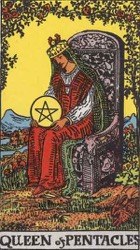 |
 |
 |
© Phuture Me Ltd 2018. All rights reserved.
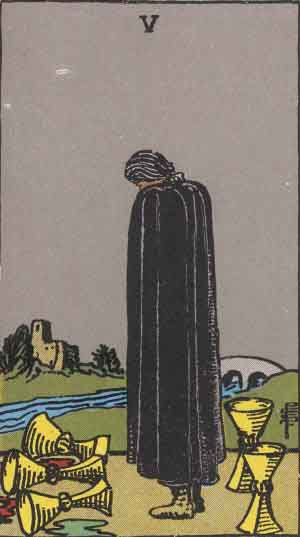
"It's no use crying over spilled milk"
The Tarot imagery for this card is, in general, one of a sad figure lamenting over turned, empty, cups. The spilled water symbolising emotional loss. In the Rider Waite Smith (RWS) deck the person stands with their head bowed, facing left or west, looking at 3 over turned cups. A character who is facing left is focused on past events and, as the spilled cups are on the left, this is a past emotional loss and not something about to happen or in the future. In the RWS card we can't see their face and they wear a black cloak as someone who is in mourning. They have shut themselves off from others. On the right, in the future, are 2 upright cups. If our sad character was to put the past behind them, turn around and move on they'd see that the future offers something new emotionally.
In Numerology the negative aspects of the number 3 are unhappiness, sorrow, heart ache and loss. (See the 3 of Swords). The positive, emotional, attributes of the number 2 can be found in the 2 of Cups. In such a negative card as the 5 of cups these two full cups give hope, pointing to a brighter future. They represent something new to look forward to. The message here is to let the past go, accept what is and move on and embrace new, emotional, possibilities and partnerships.
The 5 of Cups is a card of emotional loss, regret, melancholy, self pity or feeling blue. The element here is Water which relates to love and emotions. In numerology the number 5's positive traits are change, detachment, adaptability and freedom. The negative traits are instability, irresponsibility, carelessness, thoughtlessness and over indulgence.
© Phuture Me Ltd 2010-2018. All rights reserved.
THE PICTORIAL KEY TO THE TAROT
By Arthur Edward Waite (1911)
A dark, cloaked figure, looking sideways at three prone cups two others stand upright behind him; a bridge is in the background, leading to a small keep or holding. Divanatory Meanings: It is a card of loss, but something remains over; three have been taken, but two are left; it is a card of inheritance, patrimony, transmission, but not corresponding to expectations; with some interpreters it is a card of marriage, but not without bitterness or frustration. Reversed: News, alliances, affinity, consanguinity, ancestry, return, false projects.
Related Tarot Cards
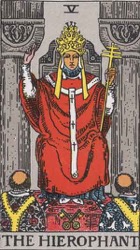 |
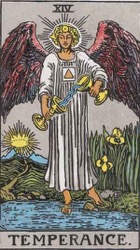 |
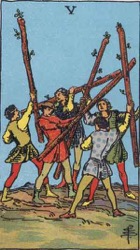 |
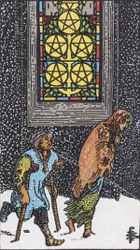 |
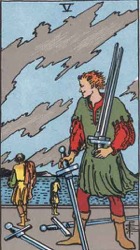 |
© Phuture Me Ltd 2018. All rights reserved.
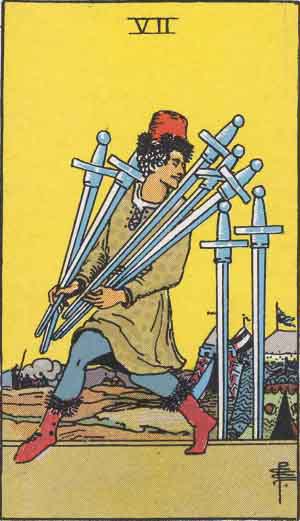
The thief card. Tarot imagery for this card is, in general, one of an act of theft. In the Rider Waite Smith (RWS) deck a man tip toes away to the left while looking over his shoulder to the right. He's stolen 5 swords leaving only 2 behind, but why didn't he take them all?
The numerology in this imagery is very important and of note. The 7 of Swords is related to the 5 of Swords. In the 5 of Swords our character has achieved his goal through force and direct confrontation. Here in the 7 of Swords the character has used stealth and cunning to achieve the same ends. The remaining 2 swords, that he has turned his back on, represent diplomacy and negotiation. He could have asked for the swords, and been honest about his intentions, but he has chosen to turn his back on that option. These two swords also serve as a link to Judgement and Justice in the Major Arcana. Both cards have numerological values of 2 and this symbolic connection may carry a warning of the consequences of his actions.
Is he smarter than the character in the 5 of Swords? He's avoided the bad publicity of the 5 of Swords open conflict. He would probably argue that his actions hurt no one, he's kept face and not lost friends.
Sometimes it's important to take note of the direction a character is facing when looking at symbolic imagery. In the RWS Deck this character is heading left but looking right. In the 5 of Swords our character looks left. The left represents the past and the right, the future. Our thief is looking to the future but he's heading backwards. He thinks he's being clever but his actions will set him back.
The 7 of Swords is a card of theft, greed, deceit and avoiding confrontation. The element here is Air which relates to challenges, conflicts and the mental aspects of our lives. In Numerology the negative aspects of the number 7 are malice, theft, cheating, craftiness, confusion and deceitfulness. The positive aspects of 7 are rest, introspection, thoughtfulness and planning.© Phuture Me Ltd 2010-2018. All rights reserved.
THE PICTORIAL KEY TO THE TAROT
By Arthur Edward Waite (1911)
A man in the act of carrying away five swords rapidly; the two others of the card remain stuck in the ground. A camp is close at hand. Divinatory Meanings: Design, attempt, wish, hope, confidence; also quarrelling, a plan that may fail, annoyance. The design is uncertain in its import, because the significations are widely at variance with each other. Reversed: Good advice, counsel, instruction, slander, babbling.

The 5 of Swords is a card of an empty and pointless victory, embarrassing or humiliating situations, quarrels and even violence. 5s are never welcome cards in any tarot reading and Swords are often troublesome. This card especially is a warning not to be taken lightly. In the Rider Waite Smith (RWS) deck the imagery is one of the aftermath of a battle. The victor picking at the remains. The defeated have turned their backs and walked away. This is a man without friends. There's no real prize here for anyone and the bleak landscape and grey sky sums up the mood of despair for all. What was the purpose of the fight? To strengthen an ego hell bent on it's desperate need to be right? The pitfall of being viewed as sanctimonious? This tragedy could have been avoided through diplomacy, listening to what others have to say, accepting differing opinions and searching for, and reaching, common ground.
The RWS 5 of Swords scene is the aftermath of a quarrel with one person looking very self satisfied and the other two, backs turned, leaving the scene. There are no friends here, no unity, only loneliness and despair. Too often we allow our views of the world, our identities, our religious or political beliefs to drive a wedge between us. By placing less value and priority on these abstract mental constructs we can build bridges between us and create harmony for all.
All the cards in the Minor Arcana numbered 5 are problematic cards. The number 5, in numerology, has the negative qualities of being chaotic, unstable, self-indulgent, irresponsible or careless and Tarot's Minor 5s reflect those negatives. If we look to the 5s in the Major Arcana we find positive cards which offer a solution to this chaos. Card number 5 of the Major Arcana is The Hierophant which represents conformity, doctrine, laws and rules that bring order from chaos. It represents not just the church and religious law but all establishments of authority which people live and work under. The other 5 in the Major Arcana is card number 14 Temperance (numerology reduces 14 to 5) which represents self control. When dealing with the 5 of Swords in a Tarot spread these additional cards maybe the warning, or the solution, of what sort of control will be applied to the unruly behaviour of this card. External control or self control.
The central character in the RWS 5 of Swords holds 3 swords symbolising the numerological link to the 3 Of Swords, the card of despair and heart ache. The 2 remaining swords on the ground are a numerological link to the 2 Of Swords symbolising the ignored diplomatic option which could have prevented this situation from occurring. They also serve as a link to Judgement and Justice in the Major Arcana. Both cards have numerological values of 2 and this symbolic connection may carry a warning of the consequences of his actions.
The Suit of Swords, representing the Element of Air, symbolises the mental and intellectual aspects of life. The storms on the path of life that we have to apply our minds and intelligence to navigate through. Like the steel in the sword we are tempered by the hammer and flames of life's challenges and trials. The negative characteristics and meaning of the number 5, in numerology, are instability, chaos, self-indulgence, irresponsibility, procrastination, thoughtlessness and carelessness. This combination of element and numerology would suggest not focusing on doing one thing well but many things badly. Not thinking things through properly and being forceful in gaining the upper hand, or short term victory, only for it to later turn against you into isolation, defeat and humiliation.
© Phuture Me Ltd 2010-2019. All rights reserved.
THE PICTORIAL KEY TO THE TAROT
By Arthur Edward Waite (1911)
A disdainful man looks after two retreating and dejected figures. Their swords lie upon the ground. He carries two others on his left shoulder, and a third sword is in his right hand, point to earth. He is the master in possession of the field. Divinatory Meanings: Degradation, destruction, revocation, infamy, dishonour, loss, with the variants and analogues of these. Reversed: The same; burial and obsequies.
Related Tarot Cards
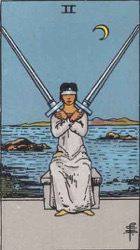 |
 |
 |
 |
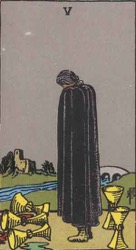 |
 |
 |
 |
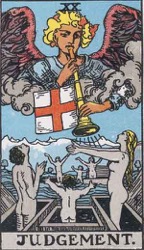 |
© Phuture Me Ltd 2018. All rights reserved.

In the Suit of Swords there's a gradual build up of stress, worry and problems as the numbers ascend. Beginning with the initial challenge of the Ace of Swords, the attempt at diplomacy in the 2 of Swords, the disappointed and heartache of the 3 of Swords continuing on until reaching a crescendo of mental, sleep depraving, anguish in the 9 of Swords. The scene in the 10 of Swords, which looks like a gruesome murder scene, is one of calm and peace. Whatever your plans were they are well and truly dead. There is a realisation here that no amount of thinking, planning, negotiation or intellectual manoeuvring can take things forward from this point.
The 10 of Swords is a card of total defeat, collapsed plans and failure. The element here is Air which relates to challenges, conflicts and the mental aspects of our lives. The storms on the path of life that we must navigate through. The number 10 reduces in numerology to 1 (1+0). The 10 of Swords, like the Ace of Swords, marks the beginning of new challenges, plans, or ideas. The difference between these cards is that the 10 marks the passing of one cycle and the beginning of a new one. An Ace makes no reference to the past only a completely new beginning. The 10 builds something new upon previous cycles, it is an Ace armed with experience. Seeing this card the message maybe to try again using a new approach with the experience of knowing what does not work.
In the Rider Waite Smith (RWS) deck the background scene is one of calm waters symbolising emotional peace and a dark night sky giving way to breaking day light and dawn symbolising a new beginning. If you go back one card in this suit to the 9 Of Swords you'll see a night time scene and someone who can not quieten their mind and sleep from worry and anxiety. In the scene depicted in the 10 of Swords night is ending, a new day is beginning and the mental fever has broken and passed. As dramatic and unpleasant as this card first appears it also has the positive, comforting, message that the worst is over. Remember that this card, and the Suit of Swords, deals with the mental and intellectual aspects of life therefore its dramatic depiction of a man impaled with ten swords does not refer to anything physical only to something abstract. Even though the imagery of this card would seem to imply Death this is not the case because the 10 is cyclic. You have no choice but to accept defeat, put whatever it was behind you and move on to a new day and new challenges.
© Phuture Me Ltd 2010-2019. All rights reserved.
THE PICTORIAL KEY TO THE TAROT
By Arthur Edward Waite (1911)
A prostrate figure, pierced by all the swords belonging to the card. Divinatory Meanings: Whatsoever is intimated by the design; also pain, affliction, tears, sadness, desolation. It is not especially a card of violent death. Reversed: Advantage, profit, success, favour, but none of these are permanent; also power and authority.
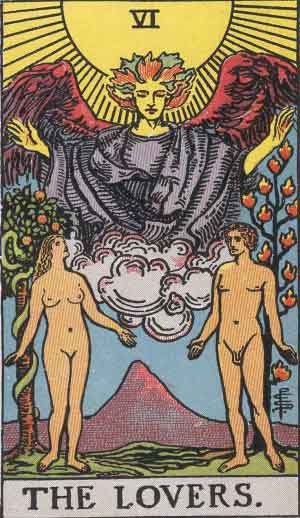
It's important to note that The Lovers evolved into Adam and Eve, in the Garden of Eden, with the publication of the Rider-Waite-Smith (RWS) Tarot deck in 1910. Traditionally this tarot card depicted a well dressed couple receiving a blessing of their union from a king. Above them, with the sun in the background, hovers cupid ready to shoot with his bow and arrow.
What theme was the artist, Pamela Coleman Smith, trying to capture with this break from tradition and inclusion of christian mythology? Many of the changes that Smith brought to Tarot could be attributed to her excellent understanding of numerology and a desire to enhance Tarot's symbolic cohesiveness. The key theme of the number 6 in numerology is one of responsibility to those closest to us; family, friends and colleagues. It is not a number of emotional union, the 2 Of Cups would be a better match. Comparing it to the emotional card of the same number, the 6 Of Cups, would suggest that it is more platonic than its name would suggest.
The nudity of Adam and Eve in the RWS deck, in addition to the card's name, often misleads to a theme of sexuality. The book of Genesis (2:25) states "Both the man and his wife were naked, yet felt no shame.". The nudity of these characters represents innocence. After eating the forbidden fruit (Genesis 3:7) they became self aware and covered themselves. Innocence lost, which is where this card makes a numerological connection to the 15th card of the Major Arcana, The Devil. In numerology The Lovers and The Devil are both 6 as 15 reduces to 6 (1 + 5). The RWS Devil shows us the same couple from The Lovers chained to an alter with the Devil sitting on it. This connection between these two cards serves as a warning of the consequences of acting irresponsibly when you are in a good place. The Lovers will often appear as a reminder to appreciate what you have and protect it from un-wise choices and temptations. There are things we do in life, or choices we make, that cannot be undone. An innocent, platonic relationship between two friends changes forever when they become lovers.
In numerology The Lovers and The Devil are both 6 as 15 reduces to 6 (1 + 5). The RWS Devil shows us the same couple from The Lovers chained to an alter with the Devil sitting on it. This connection between these two cards serves as a warning of the consequences of acting irresponsibly when you are in a good place. The Lovers will often appear as a reminder to appreciate what you have and protect it from un-wise choices and temptations. There are things we do in life, or choices we make, that cannot be undone. An innocent, platonic relationship between two friends changes forever when they become lovers.
The traditional, pre-RWS, depiction of what appears to be a marriage is probably based on Catholicism's prohibition on divorce. Once a marital union is made it cannot be broken until at least one person dies. The Lovers therefore symbolises an irreversible choice and course of action. The RWS change is probably in response to changing modern times with higher instances of divorce and re-marriage as well as the adoption of tarot in cultures not so heavily influenced by the catholic church (ie England where Waite and Smith were based.)
The sun in the background is the one symbolic feature from the traditional tarot decks that was retained by the RWS deck. In the RWS deck only three cards have the sun at its zenith in the background sky. The Fool, The Lovers and The Sun. The Lovers and The Sun are dominated by the element of Fire which is opposite to the element of Water (emotions and love). The element of fire, like the 6 in numerology, symbolises the home and community in which we live and work. The Sun brings success, abundance, fertility and growth which, according to The Book of Genesis, is what the Garden of Eden provided, everything man and woman could want in one place. A paradise that was lost due to temptation, a bad choice and evil influence.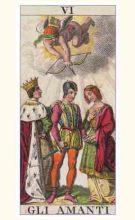
There is a prevailing theme of darkness in the Major Arcana between card 6, The Lovers, and card 19, The Sun. Nothing good ever lasts and should be treasured and appreciated when received, each day taken as a gift. When the sun does finally set, and night falls, we are comforted by the knowledge that the sun will always rise again tomorrow.
Just as the appearance of Death in a Tarot spread doesn't generally indicate the death of someone nor does the appearance of The Lovers card indicate a new love interest or a romantic physical encounter. Tarot can be literal, and on occasion this maybe the message, but it is good practice when reading tarot spreads not to jump to literal conclusions each time these cards appear.
© Phuture Me Ltd 2010-2018. All rights reserved.
THE PICTORIAL KEY TO THE TAROT
By Arthur Edward Waite (1911)
The sun shines in the zenith, and beneath is a great winged figure with arms extended, pouring down influences. In the foreground are two human figures, male and female, unveiled before each other, as if Adam and Eve when they first occupied the paradise of the earthly body. Behind the man is the Tree of Life, bearing twelve fruits, and the Tree of the Knowledge of Good and Evil is behind the woman; the serpent is twining round it. The figures suggest youth, virginity, innocence and love before it is contaminated by gross material desire. This is in all simplicity the card of human love, here exhibited as part of the way, the truth and the life. It replaces, by recourse to first principles, the old card of marriage, which I have described previously, and the later follies which depicted man between vice and virtue. In a very high sense, the card is a mystery of the Covenant and Sabbath.
The suggestion in respect of the woman is that she signifies that attraction towards the sensitive life which carries within it the idea of the Fall of Man, but she is rather the working of a Secret Law of Providence than a willing and conscious temptress. It is through her imputed lapse that man shall arise ultimately, and only by her can he complete himself. The card is therefore in its way another intimation concerning the great mystery of womanhood. The old meanings fall to pieces of necessity with the old pictures, but even as interpretations of the latter, some of them were of the order of commonplace and others were false in symbolism.
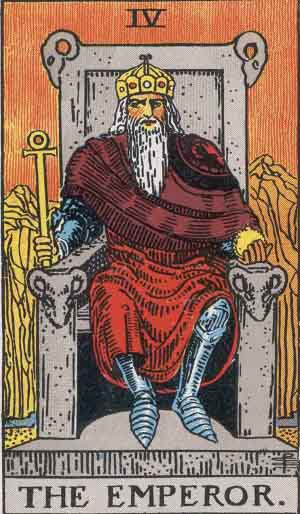
Kingdom: a country ruled by a king (or queen).
Empire: a group of countries (under one ruler).
The Emperor is the King of Kings. Each King in the Minor Arcana reigns over one elemental domain. The King of Cups is the masculine ruler of Water. The King of Pentacles is the masculine ruler of Earth. The Emperor is ruler of all 4 Elemental Kingdoms.
In the Rider Waite Smith (RWS) Deck The Emperor has long white hair and a white beard in stark comparison to his younger Kings who have clean shaven, youthful faces. Unlike The Empress he puts on no show of his wealth and domains. No fertile lands behind him, only a hint of a river running at the foot of mountains that dominate the background view. The overwhelming theme here is one of rock.
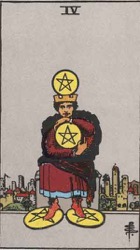
As the Empress represents being creative, or expressive, with all the elements combined The Emperor represents the solidification of the elements into a rigid, unchanging, structure. This is where the number 4 links to the number of Death, 13 (1+3=4). To survive we must continuously evolve, adapt and change. The Emperor won't and his aged looks symbolise a man who is nearing his end, who might be a bit stuck in his ways and un-willing to compromise. However he is dependable, reliable, trustworthy, an anchor in a storm.
"Men are born soft and supple; dead they are stiff and hard. Plants are born tender and pliant; dead, they are brittle and dry. Thus whoever is stiff and inflexible is a disciple of death. Whoever is soft and yielding is a disciple of life. The hard and stiff will be broken. The soft and supple will prevail.” - Lao-Tse
The Emperor represents masculinity, being in control, leadership and power. It can foretell the advancement of social, or career, status. The Emperor represents a reliable man upon whom others can depend. He is the husband to The Empress. If both of these cards appear in a Tarot spread it can indicate a married couple or a marriage. As the Empress is a mother so The Emperor is a father, or father figure.
Numerology: The Emperor is card number 4 of the Major Arcana. This is the number of stability and rigitity. This is key to The Emperor's strength but it is also a rigid and restrictive number which can also indicate a risk of stagnation or unwillingness to change. This card can sometimes represent an inflexible, ridged person, or situation, that needs to be worked around or through to reach a goal.
© Phuture Me Ltd 2010-2018. All rights reserved.
THE PICTORIAL KEY TO THE TAROT
By Arthur Edward Waite (1911)
He has a form of the Crux ansata for his sceptre and a globe in his left hand. He is a crowned monarch--commanding, stately, seated on a throne, the arms of which axe fronted by rams' heads. He is executive and realization, the power of this world, here clothed with the highest of its natural attributes. He is occasionally represented as seated on a cubic stone, which, however, confuses some of the issues. He is the virile power, to which the Empress responds, and in this sense is he who seeks to remove the Veil of Isis; yet she remains virgo intacta.
It should be understood that this card and that of the Empress do not precisely represent the condition of married life, though this state is implied. On the surface, as I have indicated, they stand for mundane royalty, uplifted on the seats of the mighty; but above this there is the suggestion of another presence. They signify also--and the male figure especially--the higher kingship, occupying the intellectual throne. Hereof is the lordship of thought rather than of the animal world. Both personalities, after their own manner, are "full of strange experience," but theirs is not consciously the wisdom which draws from a higher world. The Emperor has been described as (a) will in its embodied form, but this is only one of its applications, and (b) as an expression of virtualities contained in the Absolute Being--but this is fantasy.
Related Tarot Cards
 |
 |
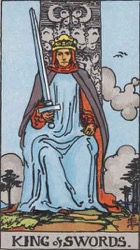 |
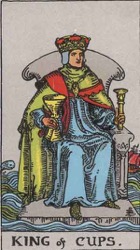 |
© Phuture Me Ltd 2018. All rights reserved.
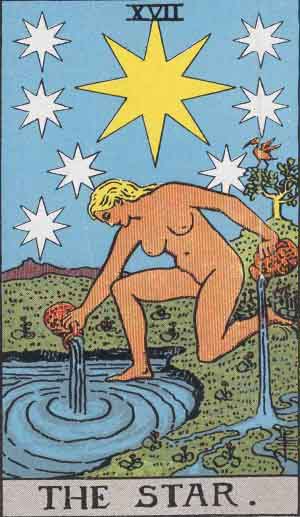
The Star is the card of enlightenment, hope, renewal, direction, navigation, success and even fame. A positive card, The Star can point to good things to come in the other cards surrounding it in a spread.
The woman is commonly depicted with one foot in the water and the other on the land pouring water, from 2 vessels, on to the land and into the water. Notice the similarity between this card and Temperance (XIV). Here the woman is pouring one container on to the land and the other into the lake/sea symbolising a renewal (or refreshment) of body and soul. Land requires irrigation for growing crops and providing food to nourish us. The lake is being refilled, the drought is over. Change is being brought about by an action which is balanced both emotionally and materially. The water represents the sub-conscious and emotions, the land the material world.
Man has navigated using his knowledge of the stars for millennia. A clear nights sky gives reference points for the knowledgable to follow. There is truth and enlightenment in this card. Where The Tower (XVI) symbolises false beliefs that crumble when tested and The Moon (XVIII) symbolises clouded, altered or veiled reality The Star is the antidote. The light that shines here is the true light that shines from millions of distant Suns. It is empowerment through knowledge. The truth that sets you free.
Numerology: The Star has the number 17 in the Major Arcana. This is reduced in numerology to 8 (1+7). The number 8 is the number of success, good fortune, wealth, power and control.
© Phuture Me Ltd 2010-2018. All rights reserved.
THE PICTORIAL KEY TO THE TAROT
By Arthur Edward Waite (1911)
A great, radiant star of eight rays, surrounded by seven lesser stars--also of eight rays. The female figure in the foreground is entirely naked. Her left knee is on the land and her right foot upon the water. She pours Water of Life from two great ewers, irrigating sea and land. Behind her is rising ground and on the right a shrub or tree, whereon a bird alights. The figure expresses eternal youth and beauty. The star is l'étoile flamboyante, which appears in Masonic symbolism, but has been confused therein. That which the figure communicates to the living scene is the substance of the heavens and the elements. It has been said truly that the mottoes of this card are "Waters of Life freely" and "Gifts of the Spirit."
The summary of several tawdry explanations says that it is a card of hope. On other planes it has been certified as immortality and interior light. For the majority of prepared minds, the figure will appear as the type of Truth unveiled, glorious in undying beauty, pouring on the waters of the soul some part and measure of her priceless possession. But she is in reality the Great Mother in the Kabalistic Sephira Binah, which is supernal Understanding, who communicates to the Sephiroth that are below in the measure that they can receive her influx.

The Fool is probably the most misunderstood but certainly the most important card in the Tarot deck. In the Rider Waite Smith deck, Arthur E. Waite and Pamela Coleman Smith's Fool is illustrated in a way that leaves The Fool's next step open to interpretation. Most who see this card just take his name and, as the human mind is so good at, fill in what's not there. A cliff and unheeded disaster. But is it a cliff? Could it just be a ledge? Is the dog trying to warn him, or is it just happy and carefree like its companion who is looking towards the heavens. The dog too appears, on closer inspection, to be looking in the same direction. Neither traveler is concerned with the ground falling away in front of them.
The Fool is related to the Pages in the Minor Arcana suits. Each minor page relates to a naive, or foolish, approach to their element. The Fool, just like the other Major courtiers (The Chariot, The Empress and The Emperor ), is a master off all the elements with a focus on the spiritual realm. He walks left, towards the past, which is symbolic of the wrong direction. Beautifully dressed he looks as if he has set out on an adventure in search for something. His focus on heaven symbolises his search for a meaning to life, a higher purpose and destiny. His intentions are good but he lacks experience and wisdom and may be going in the wrong direction. The imagery of The Fool asks a question of us. Who are we to look at someone else and think that they are going in the wrong direction? If their intentions are good, and they are following their heart not their head, how can they be wrong? The following 21 cards in the Major Arcana each symbolise the mysteries The Fool must solve, and lessons he must learn, once he finds the life path he must follow that will guide him to what he is looking for.
The Fool is unique among the Major Arcana for being the only card not to have a number. However some Tarot decks give this card a numerical value of 0 (zero). There is no numerology to constrain The Fool and he, and the Pages, are unique in being free from its cycle of numbers. The Fool represents an individual's journey through the trials of life, marked out by each of the 21 Major Arcana cards, ending with the Ascension to Enlightenment in the final card, The World.
Sometimes we need to follow our hearts not our heads or the perceived wisdom of others and trust in our own intuition.
“Your time is limited, so don’t waste it living someone else’s life.
Don’t be trapped by dogma, which is living with the result of other people’s thinking.
Don’t let the noise of other’s opinions drown out your own inner voice.
And most important, have the courage to follow your heart and intuition.
They somehow already know what you truly want to become.
Everything else is secondary.
Stay Hungry, Stay Foolish ”
- Steve Jobs, 2005 Stanford Commencement Address.
© Phuture Me Ltd 2010-2018. All rights reserved.
THE PICTORIAL KEY TO THE TAROT
By Arthur Edward Waite (1911)
With light step, as if earth and its trammels had little power to restrain him, a young man in gorgeous vestments pauses at the brink of a precipice among the great heights of the world; he surveys the blue distance before him-its expanse of sky rather than the prospect below. His act of eager walking is still indicated, though he is stationary at the given moment; his dog is still bounding. The edge which opens on the depth has no terror; it is as if angels were waiting to uphold him, if it came about that he leaped from the height. His countenance is full of intelligence and expectant dream. He has a rose in one hand and in the other a costly wand, from which depends over his right shoulder a wallet curiously embroidered. He is a prince of the other world on his travels through this one-all amidst the morning glory, in the keen air. The sun, which shines behind him, knows whence he came, whither he is going, and how he will return by another path after many days. He is the spirit in search of experience. Many symbols of the Instituted Mysteries are summarized in this card, which reverses, under high warrants, all the confusions that have preceded it.
In his Manual of Cartomancy, Grand Orient has a curious suggestion of the office of Mystic Fool, as apart of his process in higher divination; but it might call for more than ordinary gifts to put it into operation. We shall see how the card fares according to the common arts of fortune-telling, and it will be an example, to those who can discern, of the fact, otherwise so evident, that the Trumps Major had no place originally in the arts of psychic gambling, when cards are used as the counters and pretexts. Of the circumstances under which this art arose we know, however, very little. The conventional explanations say that the Fool signifies the flesh, the sensitive life, and by a peculiar satire its subsidiary name was at one time the alchemist, as depicting folly at the most insensate stage.
Related Tarot Cards
 |
 |
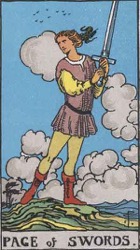 |
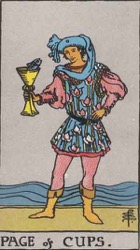 |
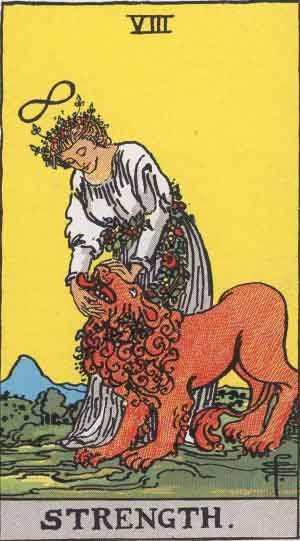
Just over 100 years ago Tarot went through a revolutionary change with the publication of the Rider Waite Smith (RWS) tarot deck. Up until this point the most popular Tarot decks had followed a structure and format based on the Marseilles Tarot. The cards in the Minor Arcana had no pictures and were closer to playing cards with pips than to the fully illustrated deck of cards that the RWS deck introduced. In addition to this radical evolution Waite and Smith also swapped the positions of two of the Major Arcana cards. Prior to the RWS deck Strength was card 11 and card 8 was Justice.
The majority of modern Tarot decks have continued with this altered numbering in the Major Arcana even though the reason Waite gave, which you can read below, was "for reasons that satisfy myself" which doesn't give much insight as to why it was so important to him or Pamela Smith. Tarot has a well ordered structure based on the foundations of the classical elements and numerology. The 8th card of the Major Arcana, according to the symbology of numerology, should have a meaning and interpretation of power and control. For this reason Strength is numerologically better suited to position 8 than Justice. In addition to this Justice as card 11, which reduces to 2 in numerology (1+1=2), links it directly to Judgement which is card 20 and also reduces to 2 (2+0=2). Therefore swapping these cards corrected and improved the overall structure of Tarot significantly.
As with all the cards in Tarot's Major Arcana Strength represents the mastery of the elements in combination with the numerology. It's worth reviewing the cards numbered 8 in the Minor Arcana to understand what it is this card has mastered. The common traits of the number 8 are ambition, discipline, practicality, being realistic and in control. Tarot's Strength card is mental strength (Swords, air and intellectual challenges), emotional strength (Cups, water and emotional issues and needs), physical and/or financial strength (Pentacles, earth and the material including health) and strength of resolve and ambition (Wands, fire and energy).
In the RWS deck the woman depicted in Strength has an infinity symbol placed like a halo above her head. This will be to remind us that the number 8 is an upright infinity symbol and that the laws of karma apply. Any action will have an equal and opposite reaction as the closed looped always returns. She is depicted as using gentle force to open the mouth of the lion. When you are in a position of strength over another remember to treat them as you would want to be treated yourself.
Strength is the card of physical well being, strength of will and controlling the inner beast. Mankind's dominance over the animal kingdom through the use of his superior intellectual strength. Impulsive animal instincts need to be controlled with strength of mind and will. In a very simple interpretation it can represent a pet or animal. Good physical health is a common theme with this card, it often represents good health if health is of concern and a focus in a reading. Surrounding cards will indicate if this health is at risk or how it can be achieved.
© Phuture Me Ltd 2010-2019. All rights reserved.
THE PICTORIAL KEY TO THE TAROT
By Arthur Edward Waite (1911)
A woman, over whose head there broods the same symbol of life which we have seen in the card of the Magician, is closing the jaws of a lion. The only point in which this design differs from the conventional presentations is that her beneficent fortitude has already subdued the lion, which is being led by a chain of flowers. For reasons which satisfy myself, this card has been interchanged with that of justice, which is usually numbered eight. As the variation carries nothing with it which will signify to the reader, there is no cause for explanation. Fortitude, in one of its most exalted aspects, is connected with the Divine Mystery of Union; the virtue, of course, operates in all planes, and hence draws on all in its symbolism. It connects also with innocentia inviolata, and with the strength which resides in contemplation.
These higher meanings are, however, matters of inference, and I do not suggest that they are transparent on the surface of the card. They are intimated in a concealed manner by the chain of flowers, which signifies, among many other things, the sweet yoke and the light burden of Divine Law, when it has been taken into the heart of hearts. The card has nothing to do with self-confidence in the ordinary sense, though this has been suggested--but it concerns the confidence of those whose strength is God, who have found their refuge in Him. There is one aspect in which the lion signifies the passions, and she who is called Strength is the higher nature in its liberation. It has walked upon the asp and the basilisk and has trodden down the lion and the dragon.
Related Tarot Cards
 |
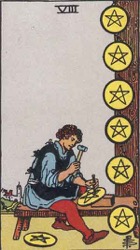 |
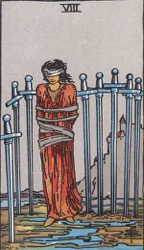 |
 |
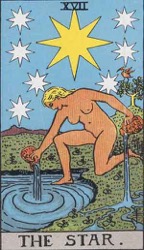 |
© Phuture Me Ltd 2019. All rights reserved.
|
This would be your opening message from you to your reader.
All our readings are conducted as a conversation, beginning with your question. At checkout you are asked to enter a personal message to your reader with any details you want to include about your situation and questions you would like answered in the reading. Our readings are not limited to our Digital Tarot Deck. We offer 3 possible formats for you to choose from: 1) Using our Digital Tarot Decks here on our website, or on our iOS App. 2) The Reader uses their own personal Tarot Deck, picks the cards for you and uploads a photo of the cards for you to see. 3) Use your own Tarot Deck to create a spread and upload a photo for the reader to view and read. Use your own printed deck of cards or a screen shot from your favourite Tarot App. All of our readers use the Digital Tarot Deck, please check each individual readers profile page to see what formats they accept for readings. Some readers may include extra cards in their readings to help answer questions, either by attaching photo’s of cards they have drawn for you, or by allowing you to add more spreads to you reading from the digital deck. Reader’s are not limited to reading just Tarot. If you browse our reader profiles, and take a look at their unique reading packages, you’ll find Oracle, Angel, Lenormand cards, Runes, Palm Readings, Astrology, Numerology and may more unique and fascinating divination techniques on offer. A unique feature of our system is the ability to have any spread read by multiple readers. This provides you with a consensus of opinion, highlighting common themes giving you greater confidence in what the Tarot is telling you. Readers can review previous readings they have given you for continuation of your issues and concerns. We provide a low volume, high quality, professional consultation service with the emphasis on giving you a personal and profound level of attention. |
|
Sometimes a reader may need to ask questions prior to giving you a reading. A few examples of this situation are:
- Just to say “Hello”, and introduce themselves if you are a new client. - They would like clarification of what it is you are asking them to look into. - You have used a spread which isn’t appropriate for the question(s) you have asked. The reader may add another spread to your reading. Our readings aren't limited to one spread only. They can combine many spreads, photos and documents if required. - The reader has ethical issues with what you are asking them to look into. You are given the option of changing your question or accepting a credit refund for cancellation of the reading. You can then try a different reader who is prepared to work with your line of enquiry. Please check our reader’s pages for further information on topics and questions they are uncomfortable with reading about. |
|
As you can see our readings are conversations and not just a cold written report but a personal service where the communication flows in both directions.
Unlike verbal readings, either in person or over a video link, you have this conversation in writing to come back to and reference whenever you need. |
|
At this point in the conversation the reader reads the cards for you. Tarot is a tool for unlocking the infallible wisdom of human intuition. When you select cards from our shuffled digital deck you are using nothing other than your own intuition to do so. All cards, face down, are equals and have the same chance of being selected. This is why a digital tarot deck works just as well as a printed tarot deck. You pick the cards not the software. The hard part with Tarot is interpreting the symbolic messages given to you in a Tarot spread. Some people have a natural gift for it due to their empathetic nature and psychic ability. Reading your own cards is difficult, as your feelings, desires and fears will cloud your intuitive voice. True psychics don't need to talk to you face to face to make a connection. There is no need for a real time connection over video or a telephone. The cards you selected, using your intuition, serve as the connection. There can be no "COLD READING" when being given a Tarot Reading via a service like this. The reader has only your question and the cards to work from. This a real test of any reader's ability. We are confident you will be impressed with our readers insights, and the personal service given to clients, by our team of consultants. All readings remain strictly confidential between you and the reader. Readers see only your spread and question. They are not given access to any other readings given by their colleagues. In Summary - No cold readings (Reader has only the cards and your question). - Ask clarifying questions on your reading after it is given. - Keep a copy of your reading to come back to and reference. - Choose a reader from a range of backgrounds, abilities and geographic locations. - Have more than one reader read the same spread for consensus of opinion highlighting common themes. - Readers can reference their reading history with you to enable them to provide clients with a continuity of situation and progress.
|
|
Now you have received your reading you can take your time absorbing what has been said. The reading remains open giving you time to contemplate it's contents. It is here that you are given the opportunity to respond to the reader, even if just to thank them, with anything your like to ask about what the reading contained or perhaps didn't answer for you. This post reading conversation can go back and forth between client and reader until the reader deems the reading concluded.
|
|
Unlike the many other psychic services online we don't aim for high volume of sales, charging per minute and dragging out conversations to our own financial advantage. We charge a fixed fee per consultation. Our readers receive the lion's share of the fees charged (see our reader application page) and are interviewed and vetted by regular clients before we allow them to join full time. This helps to ensure that our team of reader's are only the very best and share our values of care and attention to the needs of our clients.
|
| The reading is now complete and has been closed |
